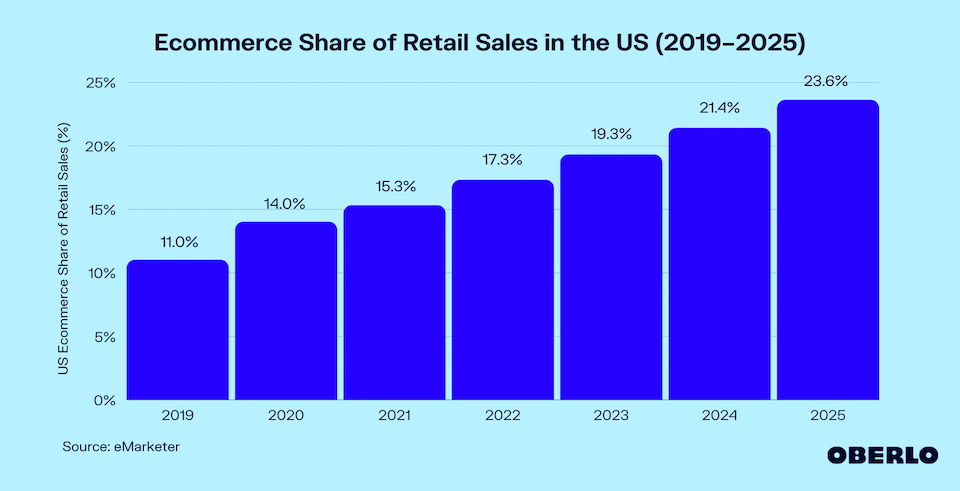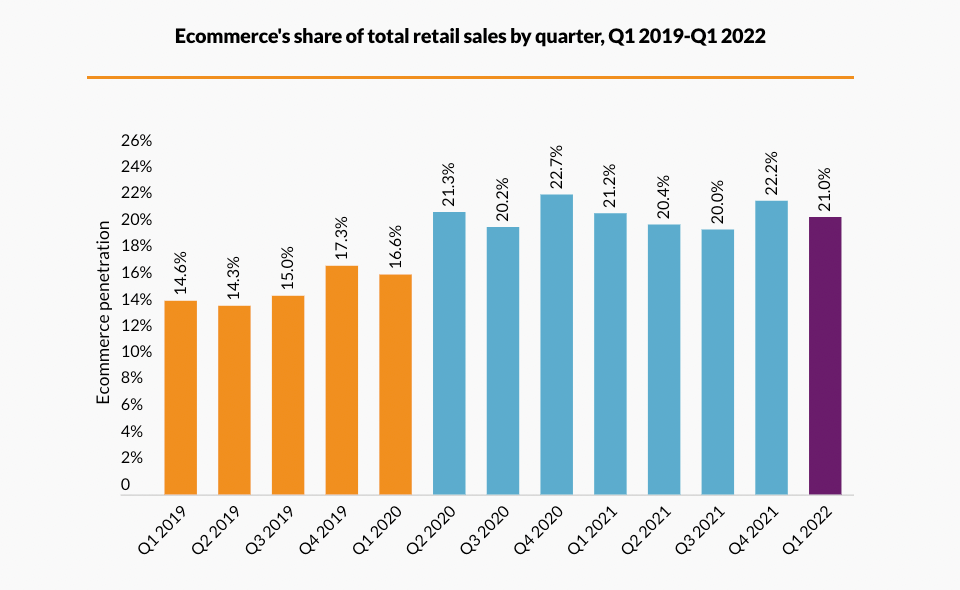
How to Increase Ecommerce Sales (20 Ways)
Apr 17, 2020|Read time: 14 min.
Key Points
- Ecommerce revenue sourced from organic traffic is experiencing double-digit growth.
- Increase your ecommerce sales through branded and long-tail keywords that target the entire funnel.
- Capitalize on what’s popular and meet your buyers where they’re at online.
- Get creative with UGC, influencers, and behavioral analysis.
Want to know how to increase ecommerce sales? Take a look at men’s fashion retailer Bonobos. The brand launched in 2007 with one thing in their inventory: pants. Ten years later, in 2017, Walmart acquired the company for $310 million.
The secret to the brand’s early success was an online customer experience that didn’t leave potential customers wanting more. This focus on user experience improved the brand’s SEO results which helped increase ecommerce sales. Bonobos created a relevant, helpful, content-rich online store for their target audience. That’s a perfect example of how to get traffic to your website.
Later, Bonobos put some power into their SEO strategy which enabled them to boost ecommerce sales. And that’s when they captured Walmart’s attention (and Walmart’s wallet).
Once an online business deploys a well-defined SEO strategy, the sky’s the limit. The optimizations magnify the brand’s traffic and boost sales to new levels. So, if SEO isn’t a major part of your inbound strategy, you’re leaving money on the table.
Ecommerce sales trends
Ecommerce has been with us for a long time (Amazon was founded in 1994). However, it’s still a massive organic growth opportunity.
Ecommerce sales were $870 billion in the US in 2021, representing 13.2% of total retail sales. In 2022, the ecommerce market share in the US is expected to reach 17.3 percent. By 2025, US ecommerce sales are predicted to account for 23.6% of total retail sales.
In other words, ecommerce sales in the US continue to increase YOY. Although the growth rate is slowing post-pandemic, the share of ecommerce sales vs retail sales is increasing.

And it’s not just that online revenue is up. The trend shows that ecommerce sales now represent a larger share of total retail sales.

But, in order to increase revenue through an effective ecommerce marketing plan, it’s crucial to analyze trends for both B2B and B2C sales.
B2C ecommerce sales
With roughly 50% of the global B2C ecommerce market share, China makes up the largest B2C ecommerce market in 2020. However, there’s plenty of room for U.S. retailers to regain market share and capture valuable search traffic.
B2B ecommerce sales
While B2C markets often get the spotlight, B2B ecommerce dwarfs B2C in size due to much larger average sales and recurring revenue models. In 2019, B2B ecommerce revenue hit $10.6 trillion, compared to $2.8 trillion for B2C. Because business-to-business transactions are often more complex, brands need to educate their audience through B2B content marketing.
Which brings us to the concept of SEO.
Ecommerce revenue sourced from organic traffic is experiencing double-digit growth. That rapidly increasing number is just the beginning of the story because it references last-click conversions only. There’s sparse information about the total number of people who discovered their favorite brands through organic search and converted later.
We do know, however, that 46% of product searches begin on Google.
Because organic traffic and revenue are tightly knit, a boost in search engine optimization is a boost in revenue. Follow the tips below to learn how to increase your ecommerce sales through SEO.
The Brand Intelligence Report
Exclusive AI insights, search trends, and brand strategies, delivered to your inbox.
How to increase ecommerce sales with SEO
1. Build brand awareness through non-branded keywords
Branded keywords convert better because those customers are specifically looking for your company. However, if that’s the primary focus of your SEO strategy, you’ll never expand your customer base.
If you want to know the secret of how to build brand awareness, then look no further than SEO. Organic search introduces your brand to new customers who are seeking solutions. As a result, you’ll expand your market share, and those new customers will begin using branded queries. Non-branded keywords also keep you top-of-mind for existing customers who rediscover your content through organic search.
2. Target the entire conversion funnel with SEO
Most digital marketing channels target one or two funnel stages — awareness, consideration, decision. Social media, for example, is strong with audiences who are in the awareness phase. But it can struggle with those in the decision phase. Paid search is the opposite. It’s strong with the purchase and consideration phases, but weak at reaching new customers at the top of the conversion funnel.
One of the best tips to increase ecommerce sales? Use SEO because it’s strong in all three phases. Take advantage of that and segment your keyword research for each of the three phases. What searches do customers in each phase make? This will become the backbone of a full-funnel marketing strategy.
For more about marketing funnels, read our article about TOFU, MOFU, and BOFU.
3. Don’t forget about long-tail keywords
More than half of all search queries are long-tail keywords. So, you should absolutely add long-tail keywords to your marketing strategy to expand your search audience and pick off low-hanging fruit. These highly-specific queries have much lower competition and a laser-focused intent. Build them into your content strategy to expand your net with each new piece of content you produce. Before you know it, you’ll be on page one for thousands of unique searches.
4. Capitalize on what’s popular using Google Trends
Even the best keyword research tools struggle to contextualize the data they share. A keyword with a high monthly search volume may have already peaked in popularity. Or, conversely, one with low volume might be on the rise. The keyword may experience a seasonal surge that changes how you prioritize it in your strategy. Use Google Trends to supplement to your keyword research by uncovering hidden terms that SEO tools don’t track.
The tool is also a window into what’s popular. Use the “Related Queries” feature to spot searches similar to your products and services. Once you spot a trend, take advantage of it! Write optimized content relative to the trend that your audience would find valuable. This keeps your content out ahead of many competitors and lets you tap into valuable keyword opportunities before they surge in volume.
5. Meet your buyers where they’re at
A hallmark of SEO is that when your audience searches for a solution, you offer the solution exactly when they want it. No interrupting their social media feed or showing them an ad while they’re engaged in something else. No hoping they’ll remember you later. That’s huge.
Meeting buyers where they’re at isn’t just about showing up in the main Google results, though. It means being on YouTube, industry websites, podcasts, review websites, etc. — wherever your buyers are, that’s where you should be, too.
Make Connections that Matter
Uncover what your customers are looking for in real time and meet their needs with valuable content.
6. Retarget organic traffic with paid ads
The fact is, meeting your customers where they are means you’re going to meet many of them before they’re ready to convert. Stay in front of your audience with retargeting ads. Remarketing is a simple and effective way to capitalize on all of your organic traffic by keeping your visitors in the funnel.
Match your remarketing campaigns to each funnel stage. When someone makes a search and lands on one of your pages, launch the ads that encourage the customer to move to the next logical step.
7. Optimize for mobile
If your website isn’t mobile-friendly, Google won’t prioritize it in the mobile search results. We’ve known this for five years now, and most major brands and enterprise ecommerce stores have already made the switch to a responsive website design.
The problem is, responsive and mobile-optimized aren’t the same thing. A website that has beautiful responsive design might still contain a plethora of elements that aren’t optimized for mobile, from custom code to images and CTAs. And Google’s not necessarily going to catch every in-page element when it gives your website the green light for the mobile SERPs.
Once you confirm that your website is generally in the clear using a tool like Google’s mobile-friendly test, reassess your website again from a user standpoint.
- Is your home page compelling and easy to use?
- How do your blog posts look? Do you break up walls of text with images?
- Do you prioritize the right information?
- Does your mobile website move at lightning speed?
- Do you include rich cards and AMP pages along with your other schema markup?
- Does the user have an easy way to fill out forms? To save things for later? Do you have a way to re-engage with them?
- Take a look in Google Analytics. Are your mobile and desktop conversion rates comparable?
In 2021, the mobile commerce share of total ecommerce was 72.9%. So, don’t miss a single opportunity and turn your mobile organic traffic into mobile sales.
8. Add copy to ecommerce category pages
Product pages capture predominantly long-tail traffic: the searches have high specificity and intent, but can be relatively low in volume. Your home page captures traffic for the broadest searches, attracting a higher volume of shoppers with lower transactional intent overall.
Your ecommerce category pages are the Goldilocks pages. They’re specific enough to be intent-focused, but broad enough to attract a large volume of new shoppers through non-branded keywords. The keywords that match the relevancy of category pages can be the strongest keywords in your arsenal — if you optimize each page in full. Add gripping, helpful, keyword-rich copy to each category page to maximize their chances of ranking for these high-priority keywords.

9. Make your product pages shine
Because some of your lowest-funnel organic traffic will head straight to your product pages, so invest in ecommerce conversion rate optimization. Show each product from multiple angles. Offer videos of the product in use. Feature beautiful graphics that set the scene: who uses your product? What does their lifestyle look like? What ideals do they embody?
When deciding how to increase your ecommerce sales through your product descriptions, don’t just give new customers your sales pitch. Give them all the information they need to make their decision. Preempt any arguments people might make against buying the product, and answer their questions. Not only does this information help the purchase decision; it can also boost ecommerce product page rankings for relevant search terms.
The results might include considerably more information than the two paragraphs of sparkling copy you want featured on the product landing page. That’s not a problem — simply keep your featured copy where it is and test out various configurations for your secondary copy. Add it below the product or create an editorial-style spread that moves the user through additional information as they scroll.
10. Implement faceted navigation correctly
Faceted navigation is the sort/filter feature that helps customers narrow down a product category by hyper-specific criteria. It’s excellent for users. It’s also not a secret that faceted search can create an SEO nightmare if it’s implemented incorrectly. Because every combination of facets creates a unique URL, websites can end up with a nearly infinite amount of duplicate content that pulls crawl from priority pages and confuses the search engines.
Solutions to the problem range from canonicalization to excluding certain URL parameters in robots.txt to implementing JavaScript that doesn’t rewrite the URL. Each solution has its pros and cons; the important part is prioritizing a solution in the first place. Otherwise you needlessly sacrifice SEO for usability.
11. Use internal linking strategically
Internal links do a lot for your website. They establish site architecture, spread link equity, and move users to other priority pages on your website.
Set up a strong internal linking structure that highlights pillar pages and helps crawlers (and people) find contextually relevant products or content.
Create best practices that establish internal links as par for the course: any time someone writes a blog post, for example, have them link to related content throughout each post.
12. Add structured data
In 2020, more than half of all searches are zero-click, meaning searches where people do not leave the SERPs to find the information they need. So a well-rounded SEO strategy today focuses on website optimization and SERP optimization.
Use structured data markup to stand out in the SERPs and highlight the information on your site that will make users want to click. While it’s not currently a ranking signal, structured data enhances visibility and helps people discover early that your site has the products and solutions they want.
For ecommerce businesses, product markup and review markup are a high priority. If you’re doing SEO for local brick-and-mortars, add location markup. View Google’s search gallery to identify the additional types of structured data that fit your industry. As you do so, note your competition’s use of structured data and make sure yours keeps up. Tools like DeepCrawl and Screaming Frog will pull this information from competitor websites, or you can look at the SERPs for specific keywords.
13. Improve the customer experience
There’s a cyclical relationship between SEO and customer experience. Improving user experience often improves SEO. So, connect users to relevant, purposeful content aligned to their search intent. At its core, Google cares about serving the most useful possible pages for any given query.
The more you can keep your audience engaged throughout the digital customer experience, the better. Make your site easy to navigate. Go above and beyond to provide all the information people need. Include compelling, quality content that satisfies their search. Eliminate broken links and website errors. Give people an easy way to connect to a standout support team. Google will love you for it, and so will your customers. What’s more, they’ll keep coming back for more, increasing your customer lifetime value (CLV)!
14. Improve page load time
The slower your site, the more profit you throw down the drain. If it takes more than three seconds to load a page, more than half of your customers will leave. The connection between page speed and user behavior is so well-established that Google uses page speed as a ranking signal for both desktop and mobile rankings.
Use a tool like Pingdom to test your site speed and implement any suggested changes. The financial and organic difference between a slow site and a fast one is profound.
If your site is struggling, read our post about how to improve page load time.
Fortune 500 Enterprise SEO Playbook
Discover how enterprise brands can create content that builds authentic audience connections.
15. Create a faster checkout process
A fast and seamless checkout process is the first rule of conversion rate optimization (CRO) because page speed and complicated checkout processes lead to shopping cart abandonment.
Just how much do abandoned carts impact ecommerce sales? Try trillions of dollars every year. What’s more, 63% of that is recoverable.
When deciding how to increase ecommerce sales, make your checkout page as speedy and uncomplicated as possible. Only ask for necessary information, and enable customer data storage for future use.
16. Give incentives for online reviews
Online reviews are massively important for branded search results. Branded keywords convert much better than non-branded terms. That’s because customers are specifically looking for your company. However, if your search results contain unfavorable reviews, those complaints could drive away conversion-ready customers. So it’s vital to gather honest, positive feedback and promote it through online reputation management.
Sadly, happy customers won’t always be motivated to leave a review without a call to action. One way to convince them is to offer incentives for product reviews. Avoid bribery by offering the same discount for any unbiased review, positive or negative, and offer it to every customer. If you have mostly happy customers, your reviews will reflect that.
17. Encourage user-generated content
UGC helps your ecommerce site rank for fresh new content and long-tail keywords. It also generates social proof by showing how loyal customers use and love your products.
If your best UGC resides on social media, creatively connect it to your ecommerce website so your SEO can benefit. Write keyword-rich blog posts rounding up the top customer photos of the week, for example. You can also build out community forums on your own website and encourage discussion. Or create a content hub for industry-related information and activity.
18. Collaborate with influencers
Links from websites and blogs and (to a lesser extent) social media mentions, help generate the trust signals that are critical to SEO success. Scalable ecommerce SEO, however, isn’t something to be done manually and in an ad hoc fashion — companies can’t invest link by link and fan by fan because of the sheer volume it takes to move the needle.
At Terakeet, we’ve developed a database of over 9 million publishers and influencers called Chorus, which enables our teams to conduct strategic outreach at scale to hyper-targeted groups of influencers. It’s through this level of scale that we’re able to achieve hundreds or thousands of high-quality content placements for each client.
Micro influencer marketing is a scalable, top-down approach. Working with influencers creates a cascading effect that starts with the influencer and trickles down to other blogs and their passionate audiences, expanding your reach, content and backlinks.
19. Use A/B testing and behavioral marketing
Because it involves testing near-duplicates of a page, there’s been some confusion about A/B testing and its impact on SEO. Rest assured, Google encourages A/B testing. Tools like Omniconvert, Optimizely, AB Tasty, VWO, and Adobe Target are some of the best enterprise-level A/B testing tools out there.
Behavior-monitoring strategies like A/B testing and behavioral marketing strategies empower you to serve an increasingly better experience to your customers through iterative testing. The results won’t just have SEO benefits; you’ll also see an increase in sales.
20. Get creative with ecommerce content marketing
SEO is deeply connected to great content and an excellent customer experience. Outside of your core technical optimizations, you have complete freedom to decide how you’ll answer the following questions:
- What kind of content will our customers find exciting, useful, and informative?
- How can we go above and beyond to delight our customers?
- How can we be featured in the news and generate buzz?
The best ecommerce content marketing is creative and engaging! When deciding how to increase ecommerce sales, try different content formats and actually have fun with the material you produce. Think of the Pareto principle and devote most of your SEO and content resources to the strategies that drive 80% of the results. Then, use the remaining 20% to experiment: test out a hypothesis, try a new content style, market to a new buyer persona.
As you expand your creative approach, you’ll uncover insights about what your audience loves. And knowing that is the key to unlocking SEO excellence and driving online sales.




